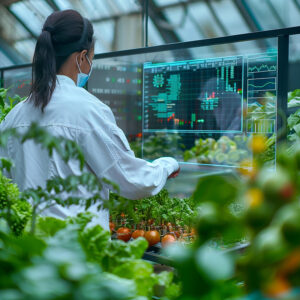Biotechnology protects corn from pests, but who protects biotechnology?

Una investigadora analiza el estado de las plantas de maíz con apoyo de herramientas digitales en el campo.
Biotechnology has revolutionized the way crops face pests, especially in corn. However, for this innovation to remain effective, proper management is necessary to ensure its durability and prevent insect resistance. If the necessary precautions are not taken, the benefits of the technology could quickly disappear.
The adoption of Bt crops in agriculture, particularly in the case of corn, has been one of the main biotechnological innovations to protect harvests against insect pests. These genetically modified crops allow corn to resist insect threats such as the fall armyworm or the stem borer. This has reduced the use of insecticides, which not only lowers costs but also promotes sustainable agriculture. Nevertheless, Bt technology is not infallible, and the way producers manage these crops plays a crucial role in their long-term success.
Proper management to ensure the durability of Bt biotechnology
Although biotechnology offers significant advantages, its success and sustainability cannot depend solely on the technology itself. To prevent insects from developing resistance, it is crucial for producers to adopt proper management and specific cultural practices. One of the keys to maintaining the benefits of Bt crops is refuge planting—an area without Bt plants where insects can find non-modified plants to reproduce. This practice helps preserve pest susceptibility to the technology and delays the development of resistance.
Systematic pest monitoring is another fundamental practice that must be carried out consistently. Producers should pay attention not only to insect populations but also to the presence of weeds that may harbor pests migrating to Bt crops. This monitoring should begin well before planting and continue throughout the crop cycle, ensuring that refuges remain in optimal condition to prevent the emergence of resistant insects.
The challenge of resistance and the commitment to proper management
One of the biggest challenges producers face is raising awareness and educating about the management of Bt crops. There is a mistaken perception that biotechnological tools are eternal or that new solutions will always appear as resistance problems arise. However, without proper practices such as refuge planting and continuous monitoring, Bt technology will lose its effectiveness over time, allowing pests to adapt.
The commitment of the entire production chain, from seed companies to producers, is essential to ensure that biotechnology continues to be a useful tool. Proper rotation of Bt proteins and crop rotation are key practices to reduce the probability of resistance. By using different types of technologies and rotating crops, the pressure on any specific Bt protein decreases, which increases its long-term effectiveness.
In addition, the use of insecticides with different modes of action, when necessary, must be carefully planned. Excessive use of products that could harm beneficial insects that naturally control other pests should be avoided.
Essential practices to guarantee the long-term effectiveness of Bt crops
To ensure that Bt biotechnology remains effective, it is necessary to implement a comprehensive approach that combines technology with responsible agricultural practices. Some key recommendations include:
- Keeping fields free of weeds that may serve as alternative habitats for pests.
- Ensuring the planting of adequate refuges and complying with recommendations from agricultural authorities.
- Periodically monitoring fields, both Bt crops and refuges, to confirm that pests are not developing resistance.
- Using pheromone traps to detect pest presence and assess their evolution.
- Consulting seed providers in case of unusual damage or insufficient pest control.
The responsible use of Bt technology ensures not only the sustainability of agricultural production but also the protection of biodiversity and the reduction of environmental impact. With proper management, pests can be effectively controlled without compromising the effectiveness of biotechnology, ensuring that producers maintain high yields while contributing to the overall well-being of agriculture.








